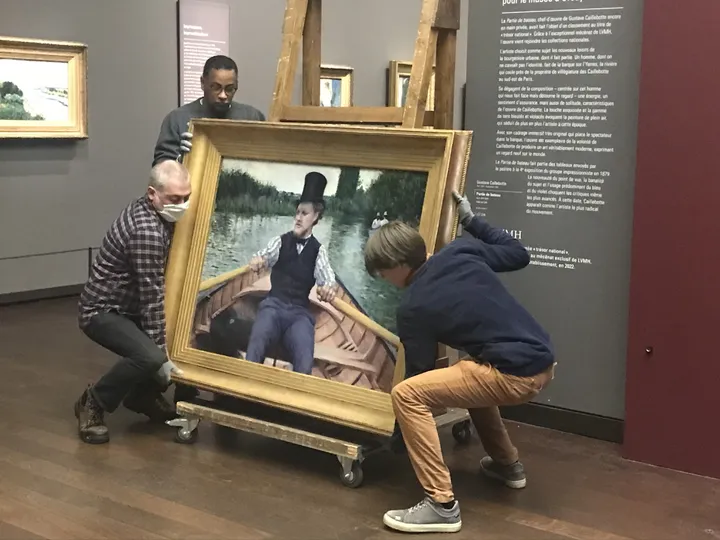It’s like an air of spring at the end of January at the Musée d’Orsay, smiles and sparkling eyes, a scent of happiness in the air, because a great painting, a beautiful painting, has just entered the collections. Partie de bateau by Gustave Caillebotte has just joined the museum’s impressionist collection. It cost 43 million € to acquire this painting, considered a National Treasure, and this was made possible thanks to the sponsorship of the LVMH group. It is an oil on canvas measuring 116.7cm/ 89.5cm out of the frame and was painted in 1878.
Gustave Caillebotte holds a special place within the Impressionists, and if he is of course known to aesthetes and other art lovers (amateur: one who loves), curiously his name is less cited than those of his illustrious peers who made the reputation of the movement. He was a friend of Renoir, as well as of Manet and Monet, and he collected their works. It is thus, curious destiny, and it took time for Caillebotte to find his rank, that of the best.
We conveniently associate his name, and by spirit of classification, with modernity, a catch-all term used like a slogan to find one’s way in time. Indeed, who is not modern in his lifetime, who does not testify with his brushes or his pen on paper? It would be more judicious to emphasize the choice of subjects and themes on which he works as well as his other impressionist friends.
Of his most famous works, The Floor Planers (Les raboteurs de parquet (Les repasseuses)) painted in 1875 (Musée d’Orsay), what do we see? Men at work, common people. It is one of the characteristics of Impressionism to represent men or women in the exercise of their professions, little people who were previously invisible in the staging of daily life. Think of Degas’ Ironworkers (Les Repasseuses) also in the Musée d’Orsay. Subjects of paintings rarely expressed until then. Contemporary life constitutes the imaginary world from which the Impressionists drew and developed an emblematic social sensitivity.
The France of the time is that of the industrial revolution, a France that is being built (thus the Orsay train station, now a museum). A France that was being equipped, the railroad being an example. Caillebotte also painted this France, The Bridge of Europe (Le Pont de l’Europe) (1876) (collection of the Petit Palais Geneva). His friends Manet and Monet also painted the St Lazare station and the steam locomotives.
Of course, we cannot forget to see in Caillebotte the witness of this urbanist revolution that is taking place in Paris, that of Baron Haussmann, the elegant beauty of these large stone buildings as a backdrop to a street scene. For example, an elegant couple, a bourgeois couple taking shelter under an umbrella, is Street in Paris, Rainy day (Rue de Paris, Temps de pluie 1877), a fabulous painting now in the United States in the collections of the Art Institute of Chicago. A way of painting that brings him closer to Cézanne and already announces cubism.

Photo C. Azzopardi
And then, let’s finally get to the initial subject of this article, to the painting that is in the news today: Partie de bateau, also called Canotier au chapeau haut de forme.
The work is sumptuous, magnificent and breathtaking and Caillebotte distills in it all that makes his great talent. First of all, what do we see? A rather young male character, with a beard, rather elegant and wearing a vest, striped shirt and bow tie, rowing in a boat, on a calm river in the middle of nature. In addition, we see on the right but in a more blurred way, another boat with two women apparently also elegant and wearing hats.
First of all, what we would call today the framing, the shooting in cinematographic language. The precision of the depth of field is quite simply admirable, the ratio of proportions perfect, Caillebotte was able to capture this rush of life (another characteristic of the Impressionists). Let us evoke the central axis which makes movement. Let us recall at this point of the demonstration the influence of Japanese painting which had just been popularized in France, and whose angles of view cut through the academicism of French painting until then. It is not by chance that Japanese tourists like to visit the Caillebotte property in Yerres in Essonne near Paris today.
Let’s come to the subject, because it is the very subject that will make the undeniable glory of Impressionism. Indeed, to paint water with its moire, its apparent immobility, and especially this space which makes link between the daily activity of the men at work and these corners of nature where one finds oneself, one likes and one resources. Country gatherings, in a way, where we dance and fool around, where we eat and drink, and where we love. A certain quality of life, a French quality. The rivers around Paris and one thinks of the Marne and its guinguettes, where Parisians come to relax on Sundays and canoe. Thus of the Grenouillère, Monet, Manet, Renoir will paint their most beautiful paintings there. Impressionism, let’s not forget, is also an intimate and direct relationship with nature, a proximity that had been used a few years earlier by the painters of the Barbizon school and especially Corot.
WUKALI is a French Art and Culture Magazine with free access on Internet https://wukali.com (click)
A broad panorama of topics : from history of art to exhibitions, books review, political sciences or animation movies and space conquest. You’ll find too a choice of articles translated in English.
Would you like to contact us, write and maybe join our merry team… Be welcome !
Contact us : redaction@wukali.com (click)


